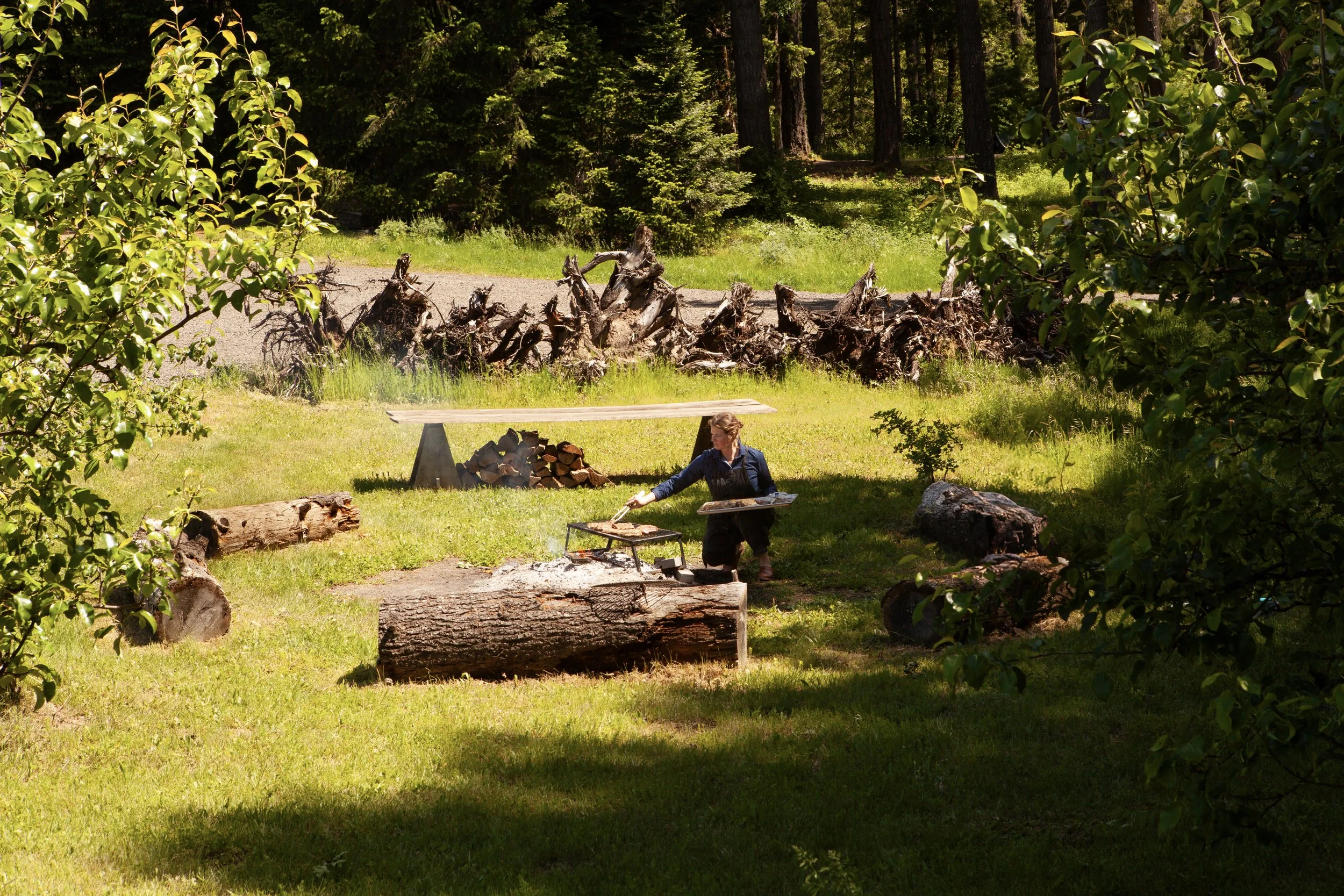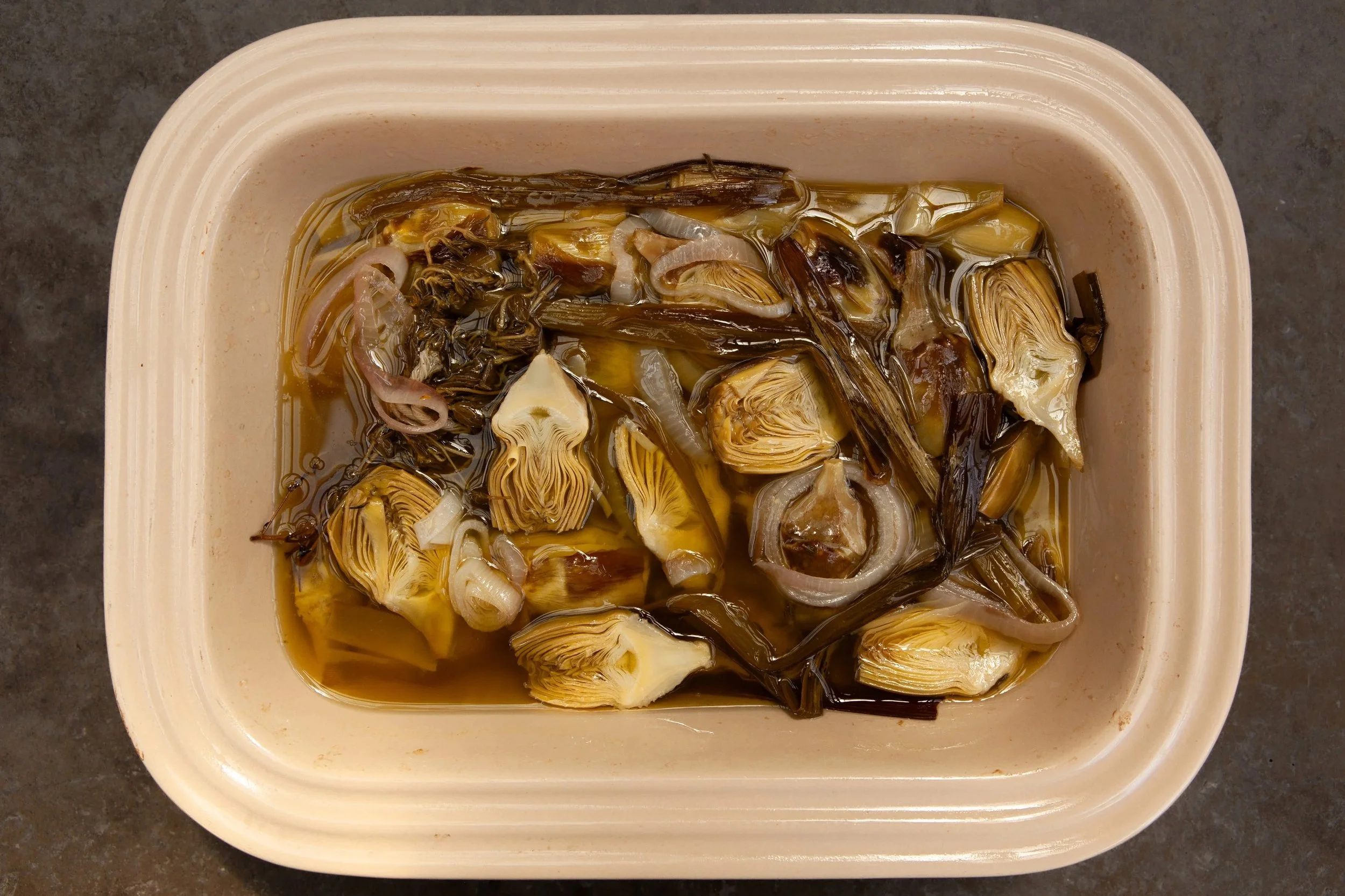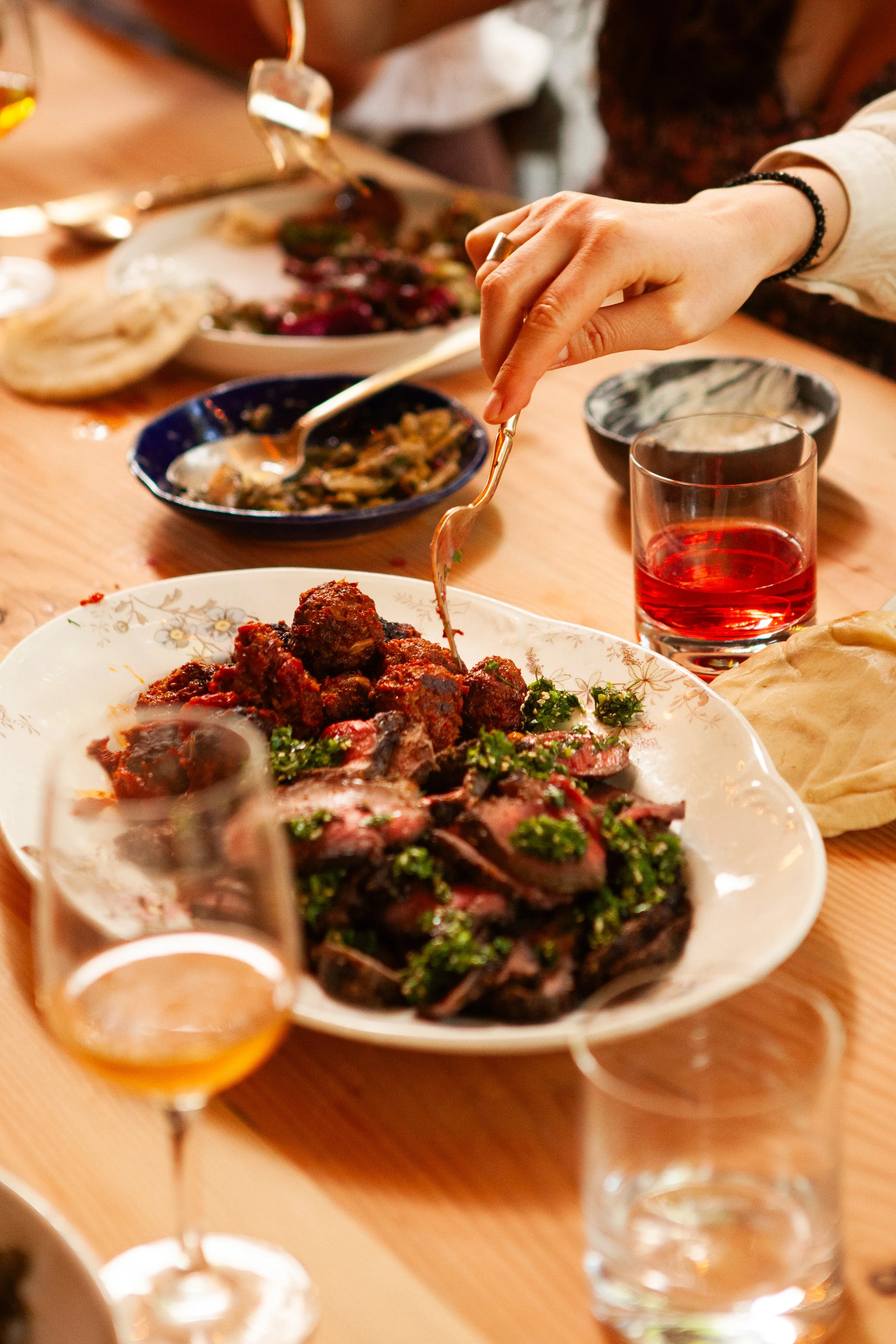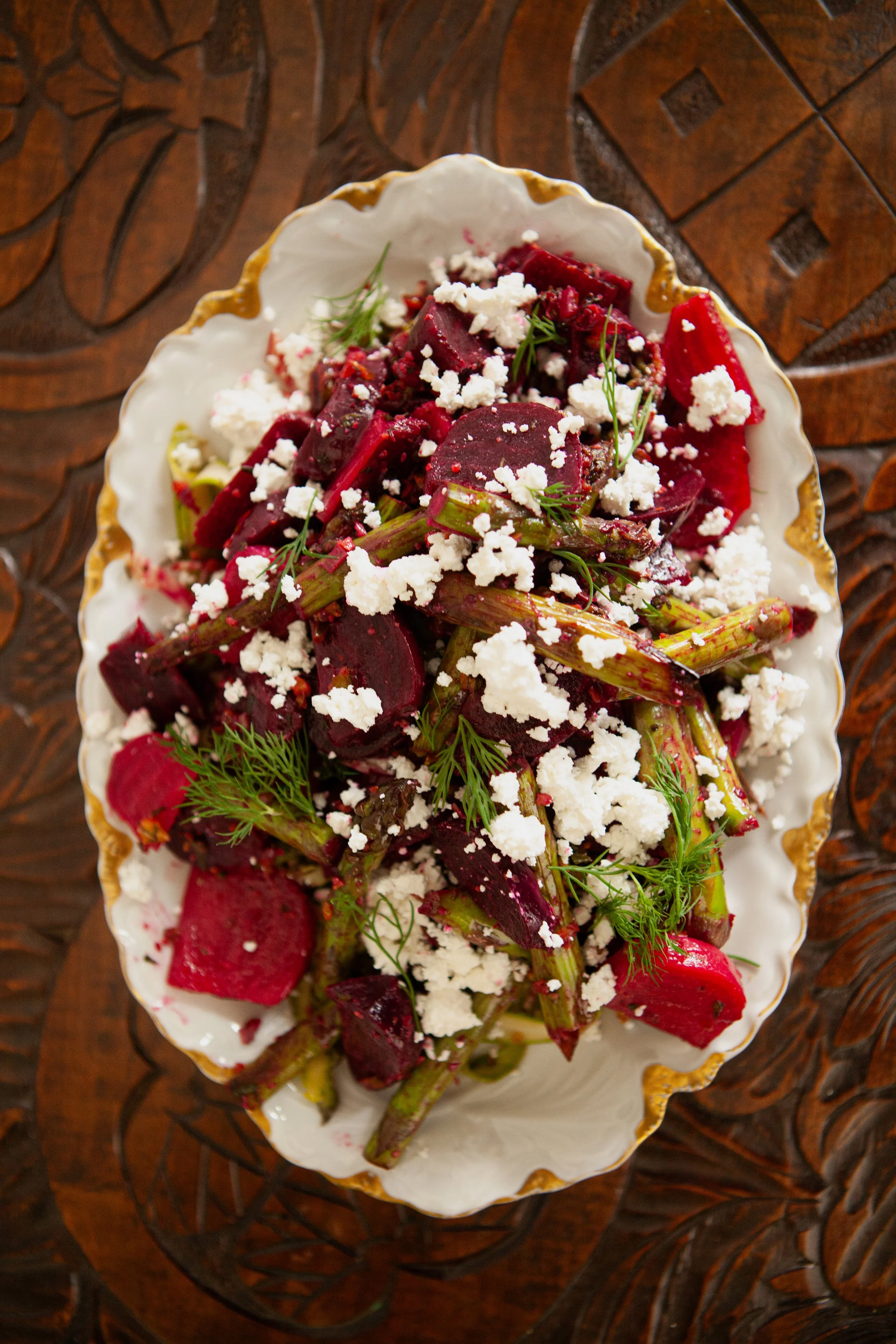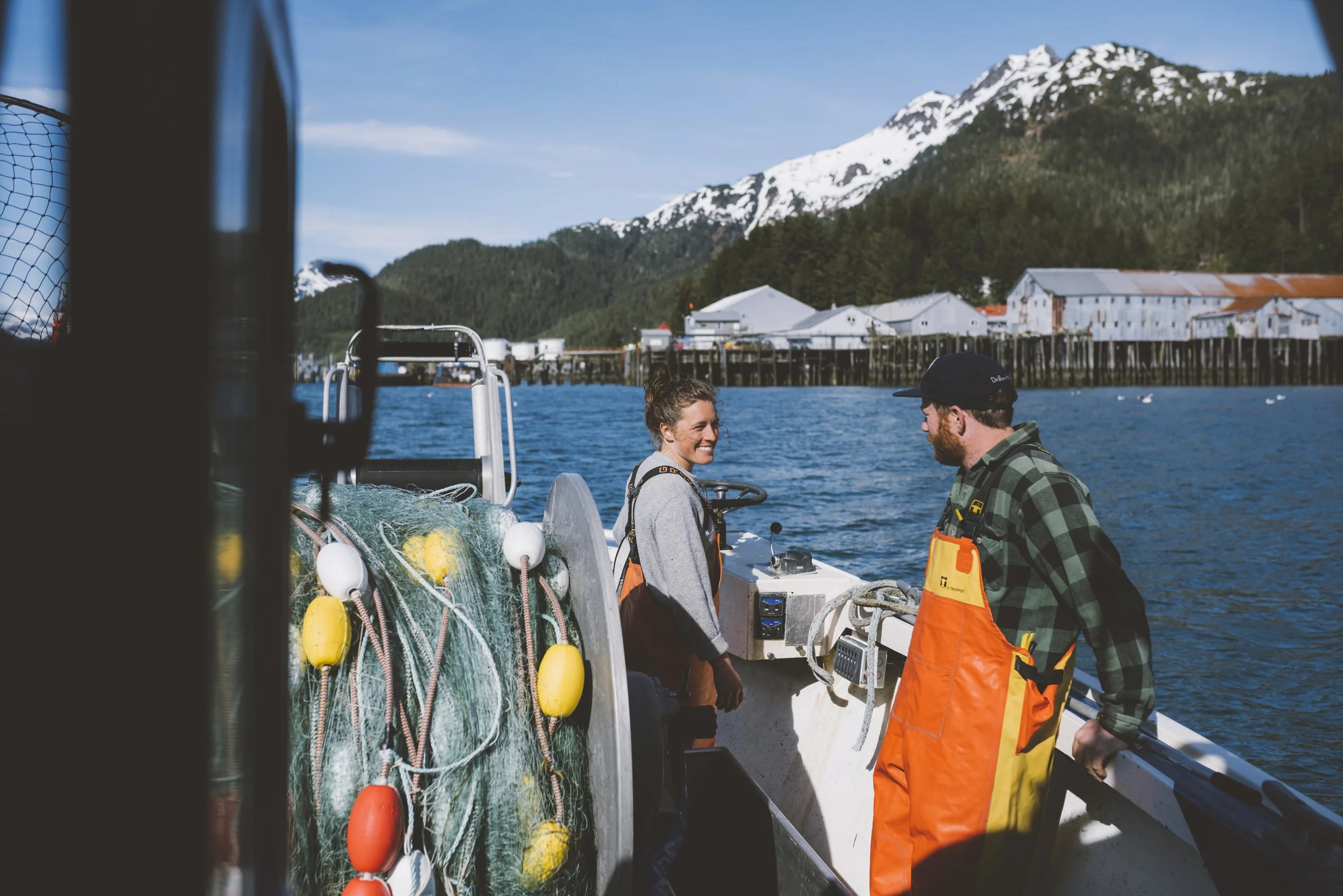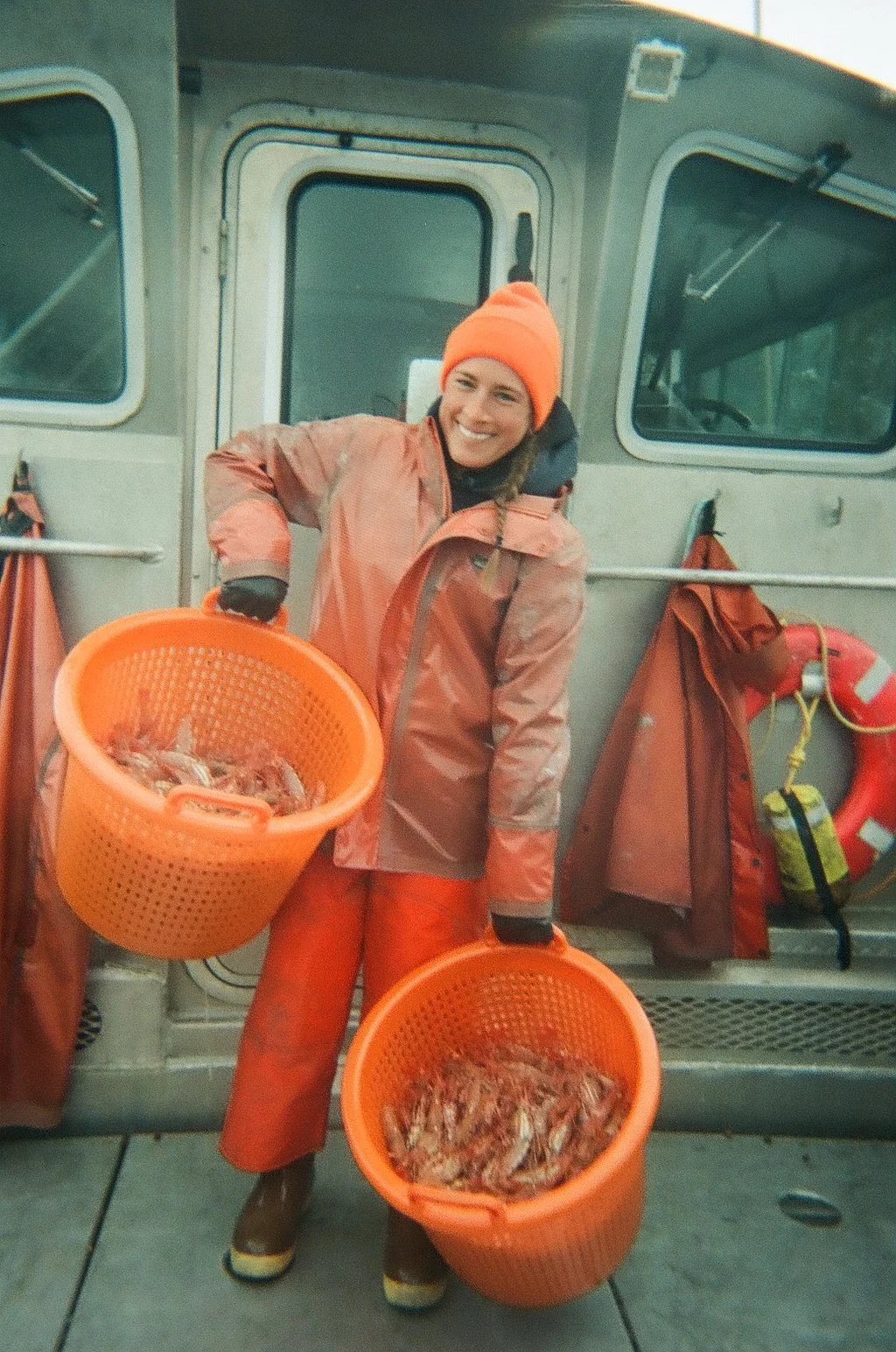Volume 5
Spring/Summer 2025
A RETURN TO THE OUTDOORS
There is an assumed ease to outdoor dining, a casualness that we welcome when the weather is willing to cooperate with our need for a simple connection with nature. Time shared with family and friends at a park, beach or in your yard or garden is a cherished experience that can be mood-altering and fulfilling. Sometimes, celebratory, outdoor gatherings have a sort of spirit that elicits fun and conviviality. Simple or elaborate, an outdoor meal defines seasonal togetherness at its peak. The physical and mental space the outdoors provides helps us to define a carefree connection that we didn’t necessarily realize we needed until it’s happening. There’s even a physiological element to a relaxing meal outdoors; when your body is less stressed, it digests more efficiently, therefore absorbing all the nutrients available in the delicious food you’ve eaten. Of course, there are many moments in the colder, darker months that afford us the opportunity to commune with nature. It’s the arrival of spring, with its murmurs of renewal and life, which then transitions into the abundance and warmth of summer that really solidifies our attraction to the out-of-doors.
Indeed, there are challenges to cooking and eating outside that require thought, a little prep and a few helpful tools and equipment to succeed. Ultimately, however, these are informal affairs that embrace the season. In every part of the world, the outdoors was our first kitchen and an open flame our first stove. Although we’ve come a long way from our primitive roots, it’s still just the basics that are necessary to achieve something delicious and special. At The Corson Building we are fortunate enough to have an outdoor wood-burning grill and oven that we lovingly use year-round. It’s in the spring and summer, however, that they get the most use. One of the many great things about our outdoor kitchen is that well, it’s outside and a retreat from the indoors is a welcome locale on a beautiful day.
If I could choose one good thing that came out of the COVID pandemic for us as a restaurant (other than the tremendous outpouring of support from our incredible community) it would have to be the expansion of our outdoor dining space. Conveniently, Corson is located on a mighty but small piece of property that allowed us to utilize the outdoor garden spaces as dining areas. As we progressed through that unprecedented time, we adapted our outdoor space to accommodate diners year-round with awnings and temporary walls which we continue to use today. We have nearly tripled our capacity, creating a space for our guests to feel safe during a time when safety and comfort were often an uncommon reality.
Whether it’s a picnic, barbeque, alfresco fête or campsite meal, eating outside often relaxes us and compels our brains to decompress (which I’m certain most of us can appreciate these days). As we transition into the warmer months of the year, I encourage you to take a moment (or many) to find a way to return to the outdoors for a nourishing meal.
- Emily Crawford Dann
INGREDIENT
ARTICHOKES
How did it come to be that someone decided to cook and then eat an artichoke? Although a beautiful plant with its deeply lobed, silvery sage-green leaves and electric purple-hued flower head, it’s not the first specimen in the garden one would be drawn to as edible. Its thorny stem and firm, pointy bracts of the immature flower bud aren’t an obvious edible vegetable. It’s not until you whittle down the scale-like leaves that protect the flower—or choke—that you discover the most prized part—the tender heart.
These traits are what lend themselves to the deep symbolism derived from the artichoke. Embodying qualities like resilience, strength, and depth, artichokes also represent hope and prosperity. Thought to be one of the world’s oldest foods, it was likely in ancient Greece that a brave and curious soul embarked on the arduous task of preparing an artichoke. Although they require some effort and a little finesse, artichokes are a celebrated and delicious ingredient in the Corson kitchen and around the world.
From its time as a curiosity in 15th-century Venice to today’s modern kitchen, the artichoke remains, well, curious. Introduced to America by Italian and Swiss immigrants, the artichoke is the edible, immature flower of the cultivated thistle. Thistles are herbaceous plants of the daisy/aster family, which typically have prickly stems and leaves as well as spindly yet spectacular purple fireworks-like flower heads. Native to the Mediterranean, artichokes thrive in temperate weather where cool, consistent temperatures enable the plants to grow slowly, which is the key to tender hearts, bracts, and stems. Artichokes now grow in many parts of the world, with coastal California producing almost the entirety of the US crop. Over the years, they have become a culinary treasure.
Roasted, steamed, simmered, grilled, fried, braised, and occasionally raw, artichokes are surprisingly versatile. They have a somewhat nutty asparagus-like flavor with a slight bitterness that is tamed once cooked. The most common variety is the globe artichoke, but there are many other heirloom varieties cultivated on small farms that are both beautiful and delicious and worth seeking out. At their peak from mid-spring into early summer, with a second, short season in the fall, the artichoke is a perennial plant that is both decorative and edible. We prefer to work with baby artichokes in the Corson kitchen due to their tender and sweet nature. One might assume that baby artichokes are the younger version of the standard artichoke, but in fact, it’s a smaller but fully developed bud that grows lower on the stem after the larger main bud has formed. Our favorite thing about these artichokes is that the choke is soft and often nonexistent so almost the entire bud can be used apart from the very outer bracts.
When choosing artichokes at the grocery store or farmers market, you should make sure, no matter the variety, that the bracts are firm and tightly layered and when gently squeezed, make a squeaking sound. The artichoke should also feel heavy. If it is light, it may be a sign that it is dried out and likely tough. Artichokes tend to oxidize quickly. Therefore, having a bowl of acidulated water at the ready is necessary to protect the prepared hearts.
With their dramatic curb appeal, artichokes are a market mainstay and an anchor of Italian cuisine both past and present. The ancient Romans preserved artichokes in honey and vinegar and seasoned them with cumin for consumption year-round. In modern Italy, they are usually preserved in oil, which leaches out fewer nutrients than vinegar or brine. Some of the most delicious preparations include thinly shaved raw and tossed with lemon juice, extra virgin olive oil and Parmigiano Reggiano and smashed and fried to a crispy flower-shaped fritter served with garlicky aioli or freshly chopped herbs.
Although early opinions of this edible thistle flower were less than glowing (Pliny the Elder and the Elizabethans were equally dismissive of the artichoke), we somehow managed to persevere and unveil its delicious potential. Whether it’s a large globe artichoke, trimmed of its spines and choke, steamed and served with mayonnaise or drawn butter for dipping, or a more laborious preparation, braised in white wine and olive oil, artichokes are well worth the effort. They may leave your hands a little worse for wear, but the delicious results will have you flaunting your hard work like a prickly badge of honor.
Olive Oil Braised Baby Artichokes
Makes 6 Servings
Thanks to my culinary mentor, respected colleague and dear friend Amaryll Schwertner of San Francisco’s Boulettes Larder, I now know and love to braise baby artichokes. Even though I learned countless deliciously interesting and unique techniques, traditions and methods while working with Amaryll, this must be one of the most valuable. When living and working in the Bay Area, it was nearly impossible to avoid working with these enticing thistle gems that have become local staples thanks to the Italian immigrants that dutifully cultivated the earliest plants upon their arrival. Braising artichokes yields a supremely supple and flavorful product that will be delicious immediately, but holds well and is essentially preserved in its braising liquid for up to a week or more in the fridge.
This method is pretty forgiving, so feel free to switch up the aromatics by adding spices or other herbs. You can also adjust the amount of oil to water as well as use wine in place of the vinegar.
Preheat the oven to 350 degrees.
Start by filling a small vessel with approximately 4 cups of cold water and the juice of 3 lemons. Remove the first few outer leaves of each artichoke. Then, one at a time, cut the tip of the whole artichoke off.
Next, with a sharp paring knife, trim the bottom of the stem and cut/peel a thin outer layer of the stem, saving as much of the inner stem as possible (sometimes they are too thin to accomplish this, but it is always worth trying). Cut the artichoke into either halves or fourths, depending on your preference. Immediately immerse in the acidulated water and continue this process with each artichoke.
Once you have prepped the artichokes, combine the rest of the ingredients in a small baking dish. Drain the artichokes from the acidulated water and add to the oil/water/vinegar mixture in the baking dish, making sure they are well coated with the liquid. Cover with foil or a lid and place in a 350-degree oven for 30-45 minutes.
Check after 30 minutes, and if the top of a paring knife inserts easily, they are done… they will likely take a bit longer (sometimes up to an hour, but usually around 45 minutes).
At this point, the artichokes can be enjoyed as is or cooled and stashed in their cooking liquid in the fridge for up to 10 days. The cooking liquid is a great base for a soup or when folded into a batch of cooked grains or beans.
Some serving ideas are:
-Spooned over fresh ricotta, fromage blanc or sliced feta with warm crusty bread.
-Combined with simmered leeks, potatoes, soft boiled egg and aioli as a simple but delicious vegetable side dish or salad.
-Mixed with olives, capers and chopped parsley for a flavorful accompaniment to most fish or with grilled lamb.
-Combined with slivered raw artichokes, arugula, shavings of parmigiano reggiano, anchovies and breadcrumbs as a salad.
WHAT YOU’LL NEED
10 baby artichokes
1 cup extra virgin olive oil
1 cup water
1/2 cup white wine vinegar or white wine
4 garlic cloves, peeled & smashed
1 shallot, peeled and sliced
6 sprigs fresh thyme
3 sprigs fresh oregano
4 thin lemon slices
2 tablespoons Kosher salt
WINE
How We Build a List
It wasn’t always in the cards to have a career in the restaurant business. Sure, I absolutely loved eating out at restaurants as a kid and started cooking for myself at age fourteen when I ventured into vegetarianism, but making a career in food…it just wasn’t on the radar. Then, before I knew it, I was making sandwiches at Hogan Brothers Acoustic Café during my freshman year of college and the rest, effectively, is history. Finding my way to the wine and beverage side of the business, however, was a bit more of a meandering path. As the elder statesman of my college friend group, I often found myself spearheading the keg runs to the liquor store in Minneapolis. When these escapades inevitably took longer than expected, I often found myself drifting around the aisles of the wine section, picking up bottles, taking in labels and occasionally buying something and bringing it home to drink on a Tuesday night. While I had no idea what I was doing, I sure was having fun. Randall Grahm’s Cardinal Zin and Penfold’s Shiraz were early favorites—robust and fruit-driven numbers tailored to an unrefined palate. Little did I know, however, that the match had been lit and the first few embers of my fledgling wine career were already underway.
It wasn’t until I arrived back in Seattle after a brief stint in San Francisco, however, that the wheels truly started to turn. Although I was still fairly green (cooking was always my restaurant gig), I managed to twist a few arms and land a serving position at Matt Dillon’s original Sitka & Spruce location in Eastlake. Within the confines of this tiny and idiosyncratic space, I found a love for serving people and working with delicious food. After a few months, I was lucky enough to be given the reins of the small and eclectic wine list that Matt had initially curated. Everything—menu and wine list alike—was handwritten on a double-wide chalkboard. Space on the board, more so than budget, was the limiting factor of what we could offer. It was pretty simple: 5 whites and 5 reds by the glass, perhaps a sparkling, perhaps a rose, and always a few special by-the-bottle selections. All in all, we had perhaps twenty offerings in-house. Working within these parameters taught me a couple of things. First, make sure every bottle you feature has a story. Second, when given the chance, always choose a wine that has an outstanding sense of place and acts as a representation of its appellation or region. While I didn’t yet know or understand the terms of art, I was already feeling passionate about the role of terroir and typicity.
As my first few years at Sitka passed, I took on a moonlighting position working for the late, great Dan McCarthy at McCarthy & Schiering Wine Merchants on the top of Queen Anne Hill. Dan’s tasting policy for his employees was always incredibly generous: if the store’s customers were well attended to and the aisles were clear, associates were always encouraged to join in and learn from the wide range of trade representatives that visited the shop on a daily basis. One day, you might meet a polished Bordelaise pouring classified growth, dignified Cabernet from venerable vineyards, the next day you could be rubbing shoulders with a scruffy biodynamic grower plying their trade in a far-flung corner of the Willamette Valley. Frankly, it seemed like Dan loved meeting and tasting with all of them. I took this outlook as an inspiration, and it too shaped the way I approached the people I encountered in the trade and the wines I chose to serve. Limiting yourself to what you knew and were comfortable with was doing an injustice to the clientele you were serving.
Which brings me, quite belatedly I admit, to the theme of this article; namely, the principles and methods that we employ in building our wine and beverage program here at The Corson Building. We are fortunate, extremely fortunate, in fact, to have all the creative license that we might want and need in building a wine list at our humble establishment. While we do have financial obligations that limit us from pursuing the most eye-wateringly expensive bottles, we are capable of working with a wide range of price points. With that in mind, we can be expansive. We don’t have any regional obligations or dogmatic constraints that bind us. Instead, we look to our own ethos that we’ve crafted over nearly 20 years in the business. In essence, we strive to serve wines that match the standards of the food that we serve our guests. We seek family operations that are deeply committed to their craft and passionate about what ends up in the bottle. For us, this means a careful evaluation of farming practices, with Biodynamic viticulture being our gold standard. Within the winery, we seek producers who are non-interventionists, which doesn’t necessarily mean they disregard tradition. To us, tradition is not a poisonous term, nor one that implies conventionality. Instead, at its best, it points to a touchstone of excellence.
These guidelines, however, are more philosophy than practicality. How is it that we actually choose and select the wines that we serve? For us, it is important to provide a snapshot of a given region, a look at the breadth and potential of a particular place. To do this, we seek producers that are benchmarks for their appellation and beyond. Domaine Huet in Vouvray and Lopez de Heredia in Rioja come to mind in well-known districts. In lesser-traveled places, Le Piane in Boca or Venica in the Collio are great examples of standard bearers. When we come across lesser-known vignerons who are reaching these heights, we are always eager to feature them. We are truly blessed to work with some incredible distributors here in Seattle and they are always eager and willing to bring us new and exciting producers to pique our interest. I am forever grateful for their hard work and the conversation and reflection that surrounds these sit-downs is always a highlight of the week. The days of grinding 8 to 10 tastings a week may be behind me, but I still love putting in the work of exploring what is appearing in our abundant Seattle market. It’s our duty to curate something special from the vast world that’s available.
In the end, building a wine list is an intensely personal endeavor. As we approach the process, it’s impossible to ignore the impact of your own tastes and preferences. To make a truly reflective list, however, it’s imperative to look beyond these constraints and consider what the clientele might also appreciate. What better challenge than finding a Washington Cabernet that’s structured and dense, but also refined enough to suit the nuances of Emily’s food (Reynvaan, anyone?)? Writing a winning list is like unlocking a challenging puzzle with numerous layers, creating ever-deepening challenges. I feel so lucky to have the opportunity to work on this ever-evolving project. It’s exciting to know that a few years down the line, our list may be entirely different with a new set of producers carrying the torch for their home regions. The prospect of unearthing these treasures is something that keeps driving me to continue to taste and explore on your behalf!
-Matt Dann
EVENT
Rites of Spring Dinner at Orchestre
Matt, my partner in both life and business, whom I love, adore, and respect deeply, has many passions but the one that stands out most is his love and devotion to competitive cycling. He has been dedicated to this discipline for almost two decades now and it’s not only how he stays physically fit but also how he connects with his thoughts and clears his mind. I would be remiss to say that this very time-consuming pastime doesn’t occasional interfere with the often chaotic and very full lives we lead as parents and business owners, but I know with complete certainty how important it is for him to have this. It’s crucial for all of us in these busy and often disconcerting times to have a way to disconnect from all these realities or, to the contrary, think deeply about them. For me, well, it’s been difficult to find the thing I love to do that affords me these moments of respite and rejuvenation. Feeding people and working with the remarkable ingredients I’m fortunate to use is not only my work but also my passion. My love for my work is vast, so the division between my professional life and personal life is so blurred it’s like a brackish waterway. This being the case, it’s the moments when I get to explore my craft away from the comforts of home or work that are priceless and restorative.
Orchestre is the brainchild of my dear friend, Charlie Kitchings. This magical jewel is situated on the property that he owns with his wife and my dearest of dear friends, Amanda, in White Salmon, WA. Orchestre is a beautifully thoughtful, creative space for cooking, gathering, and collaborating. I’ve had the tremendous fortune to escape to this inspiring space for long weekends of writing (this is where I usually go to author the very pages you are reading now), cooking, foraging the property for edible and decorative treasures, and lingering over lazy morning coffees. I’ve also been lucky enough to host dinners and parties accompanied by Charlie’s impeccable set lists derived from his wildly diverse record collection! This has become my retreat. It’s the space I go when I need to recalibrate and connect.
It was May when we decided to do our Rites of Spring Dinner at Orchestre. Spring is undoubtedly my favorite time of year—nature is resurrected from its winter slumber, encouraging us to do the same. The vibrant green that cloaks the landscape is also mimicked in the food we often associate with this time of year, making it a lovely and vibrant time to cook. Our point of departure was (and always seems to be) the season as well as the metamorphosis that this time of year symbolizes. The shift from the indoors to the outdoors, roots to buds, closed doors to open windows, stems to leaves, darkness to light, and seeds to flowers is palpable.
I knew that all the verdant green treasures would play a leading role in our dinner, but I also wanted to feature a whole lamb raised by our friends Merrit and Pierre of M&P Ranches (who we featured in our very first volume of Digest) just down the road in Goldendale, WA. We associate lamb with spring due to our agrarian pasts when the seasons ruled our diet and lamb was most abundant at this time of year. We also love how beautifully it pairs with so many of the ingredients available in the spring.
With a trip to the local farmers market, a car loaded with delicious ingredients from Seattle and a lamb delivery from Merrit, a list was written and eventually a menu started to take shape. Along with the ingredients, the way in which we cook them is carefully considered. Fueled by wood from the property as well as local orchard clippings, the wood oven is an important part of the Orchestre space and a main component of our dinner. Charlie has become well acquainted with the ebb and flow of wood oven cookery and one of his many rolls in this ensemble is maintaining the fire.
Amanda, in true hummingbird form, was fluttering about beautifying the space both inside and out as well as setting the tables. Along with friend and neighbor Judy and super fortunate guest appearances by friends, Jaclyn and Ashely, we were all working together to create a truly delicious and inspired meal.
With the arrival of guests, the rhubarb and chamomile kirs are poured and the fried morels and radishes with nettle butter are passed as folks mingle inside and out while listening to the start of Charlie’s record set. After seating our guests, we always welcome them with a quick introduction and description of what they’ll be eating, as we don’t usually provide a printed menu. In an effort to use the entire lamb, there are many preparations featuring the various parts of the animal. To start, we made a broth from the bones roasted in the wood oven and infused it with green garlic tops, fennel fronds, and leeks. We served it with fava beans, watercress, orzo, and grated sheep’s milk cheese. Braised shoulder smothered in long-cooked greens and herbs, grilled loin, leg, and meatballs are all plattered together with salads of asparagus, artichokes, beets, and turnips, pickles, sauces, and flatbread to accompany.
Birthdays are celebrated, wine is shared, friendships formed, and many conversations are had over a thoughtful meal we created together. This gathering highlights the very mission of Orchestre: A coming together of many disparate parts to create a cohesive, shared experience for all.
Charlie once told me that he believes that when you’re free of an agenda, the most remarkable ideas are formed. Removing the pressure of accomplishing or completing a certain task allows your mind to wander and meander, making space for new thoughts to develop. It’s this approach that I try to employ while I’m at Orchestre. Through conversation, moments of solitude, laughter, collaboration and togetherness I end up inspired and invigorated. It is such a gift to find balance amidst the familiarity and closeness of dear friends and the space for exploration they afford you.
PRODUCER
Drifters Fish
As a symbol of abundance, fertility, prosperity, and renewal, salmon is a sacred sea creature revered in the Northwest and beyond. All salmon hatch in freshwater, mature in the ocean, and return to their place of birth to spawn and die. This cycle of life is celebrated and respected by all Northwest Coast Cultures. Salmon have been the primary food source for Northwest Coast Native Americans for thousands of years. Some believe that salmon are immortal humans that live in villages deep under the ocean. In the spring, these immortal humans put on salmon disguises to offer themselves as food to the people. After the salmon were eaten, the skeletons were thrown back into the water with the belief that their spirits would rise and turn back into salmon people, thereby contributing to the cycle of life. When there are shortages of salmon in a given year, it is believed to represent a lack of respect for the salmon’s life cycle. Therefore, the seasonal return to their spawning grounds is celebrated and revered.
Nelly and Michael Hand, proprietors of the small fishing company, Drifters Fish, operate as committed stewards who treat the fishery with this same degree of respect. Located in Cordova, Alaska, at the mouth of the Copper River, Drifters Fish is a true mom and pop operation, with the two of them handling fishing, processing, and shipping duties entirely on their own. Although salmon is their focus, they also harvest spot prawns in the spring, Tanner Crab in the winter, and black cod in the late summer.
A gifted fisherwoman, lover of the outdoors, and talented cook, Nelly grew up in a fishing family and spent her high school and college summers working in Alaska on the family boat. Inspired by her proximity to nature and her love of a good meal, Nelly has continued living and working closely with wild fisheries and is dedicated to maintaining sustainable practices.
Michael started commercial fishing on his cousin’s boat in 2006, beginning a career that would eventually lead him to purchase his own boat a few years later. He and Nelly met through the fishing community and have been fishing and adventuring together ever since. Together, they now operate a small boat in Prince William Sound where they carefully pick salmon one by one from their nets. Each fish they catch is individually bled, gutted, and nested in layers of ice. Cleaning each fish as it comes out of the ocean helps maintain the high-quality flavor and taste of their beautiful catch.
We have been receiving supremely delicious sockeye from the Hands for several seasons now and we always welcome the opening day of the Copper River season with great anticipation. We believe they provide the best salmon we have ever been fortunate enough to work with. With its vibrant orange flesh and shiny silver skin, this salmon needs very little for it to delight your taste buds. We love it pan-roasted until the skin is crispy (my daughter’s favorite part) and the flesh just cooked through. When served with other beloved spring delicacies like wild morels or tender pea tendrils, Copper River salmon never disappoints.
As much as we cherish the mighty salmon, we might be just as smitten with another Northwest sea treasure, the spot prawn. The spring shrimp fishery is quite small, and the harvest is managed sustainably in Prince William Sound. Nelly and Michael use small pots and set their gear out in the cold glacier fjords to harvest these delicious shrimps from the deep water. They have a plate freezer on their boat and flash freeze the shrimp at -30 degrees just an hour after pulling up the pots. The quality that they achieve by flash freezing is unparalleled, providing a level of freshness second only to eating a prawn moments after it is caught. Being an incredibly perishable product, we have found this to be the best way to enjoy the sweet decadence of this special treat. Quickly poaching or roasting them in their shells before peeling them yields one of the best-tasting crustaceans on earth.
“Taking care of wild places and being committed to the stewardship of Alaska’s rich, vital coastline is so important to us and to our lives as fishermen” says Nelly. Their dedication to their craft allows us to trust them to thoughtfully harvest and process these exquisite fish. Together with a select few restaurants in Seattle, we take great pride in serving this fish to our guests and in our homes, knowing that it traveled through the caring hands of two remarkable humans doing their part to contribute so thoughtfully to the cycle of life.
STEP BY STEP
Green Sauce
Could there be a more useful condiment than Green Sauce? In our opinion, nope! The multitude of uses one can muster from a jar of minced herbs, alliums, oil, a little acid and sometimes spices or nuts is significant. Drizzled over grilled or roasted vegetables, accompanying literally almost every seafood or grilled meat, swirled on top of yogurt or fresh cheese as a dip, mixed into a pot of beans, soup or grains and even loosened with a little more oil and acid as a dressing for a salad, green sauces never fail.
Often the term green sauce is referring to its most traditional European version, salsa verde, which, not surprisingly, translates from Italian and Spanish to “green sauce.” Parsley plays the lead role in the typical version of this sauce but can easily be swapped out for other herbs depending on what its being served with or even what you have on hand.
There are as many versions of this sauce as there are shades of green. Throughout Europe, Latin America, Africa, Asia and the Middle East, interpretations of green sauce exist with each region making it uniquely their own. We’ve listed three of our favorite green sauces for you to incorporate into your home repertoire. Admittedly, these may stretch the meaning of green sauce beyond its more familiar interpretations. Our intention is to encourage you to think outside the box a bit and work with what’s on hand. Please know that these are merely guidelines and that you need not be precise. Swapping one herb for another per your personal taste or for what is available is exactly the way these sauces are meant to be used and made. With this in mind, we hope you have fun and enjoy the addition of one of these lively herbal sauces to brighten up any meal.
Salsa Verde
Makes 1 1/2 cups
Potentially the mother of all green sauces. Our version of this sprightly concoction is inspired by the Italian version. This sauce can be found on our menus year-round and is always a quick and delicious way to elevate almost anything it touches. Use it as a perfect addition to fresh ricotta for a quick appetizer with crusty bread or crackers. It’s equally delicious with beans, roasted or grilled vegetables, as a marinade for anchovies, with steamed shellfish or on top of grilled, roasted or braised meat.
What You’ll Need
1 bunch parsley, finely chopped
1 tablespoon capers, minced
2 teaspoons shallots, minced
1 teaspoon (roughly 1 large clove), grated on a microplane
1 teaspoon lemon zest (roughly the zest of 1 lemon)
¾ cups extra virgin olive oil
Pinch of chili flakes
1 teaspoon kosher salt
Mix all the ingredients together in a bowl.
Taste and adjust with salt as necessary.
Serve immediately or store in the fridge for up to a week.
Drizzle on everything!
Not listed, but a great addition, would be a couple of minced anchovy fillets
Chermoula
Makes 1 1/2 cups
Hailing from Northern Africa, this extraordinary sauce is traditionally used with seafood. Both as a marinade and a finishing sauce, chermoula adds an abundance of flavor to everything from roasted or raw vegetables, grilled chicken or lamb and all varieties of seafood dishes. We like to marinate meat in chermoula before it goes on the grill, drizzle it atop steamed halibut or clams, swirl it into a batch of tuna salad or toss roasted carrots in it when they come out of the oven.
What You’ll Need
1 cup packed cilantro (stems & leaves)
1 cup packed parsley leaves
2 tablespoons cumin (toasted and ground)
1 tablespoon Hungarian paprika
1 teaspoon pimento de la vera (smoked paprika)
2-3 garlic cloves
5 scallion tops
Juice of 2 lemons
2 tablespoons red wine vinegar
1 cup extra virgin olive oil
2 teaspoons salt
In a food processor pulse the garlic and scallion tops until minced.
We would normally suggest hand chopping an herb sauce but because chermoula has vinegar in it, the sauce will oxidize even if hand chopped so we make an exception here.Add the cilantro, parsley, cumin, and paprikas and pulse until minced.
Add in the salt, lemon juice and vinegar.
With the machine running, drizzle in the olive oil until an emulsified sauce forms.
Taste and adjust seasoning if necessary.
Serve immediately or store in the fridge for up to a week.
Pistachio Mint Relish
Makes 2 cups
This sauce is a play on a pesto, pistou or even gremolata. Without being blended into a paste, it is more like a relish. We love nuts for their depth of flavor and of course, texture in the kitchen at Corson. In our opinion, nuts combined with herbs is a match made in garnish heaven! This sauce or relish is a fantastic accompaniment to most veggies but we especially love it with asparagus in the spring, eggplant or green beans in the summer, pumpkin in the fall and beets in the winter. We also suggest adding it to a grain salad, pasta, on top of feta or sprinkled over a bowl of pureed cauliflower or root vegetable soup.
What You’ll Need
3 tablespoons shallots, minced
1 tablespoon garlic, minced
2 tablespoons honey
1 cup pistachios, toasted and finely chopped
1 ½ cups mint leaves, finely chopped
½ cup tarragon leaves, finely chopped
2 tablespoons preserved lemon peel, minced
1 ½ tablespoons fennel seeds, toasted and ground
1 cup extra virgin olive oil
1 tablespoon salt
In a small sauté pan, sweat the shallots and garlic over medium heat in 3 tablespoons of olive oil until translucent.
Add the honey until it softens into a liquid state.
Pour the shallot-honey mixture into a small mixing bowl and let cool for a few minutes.
Add the remaining ingredients into the bowl and mix well.
Serve immediately or store in the fridge capped in oil for up to a week.


